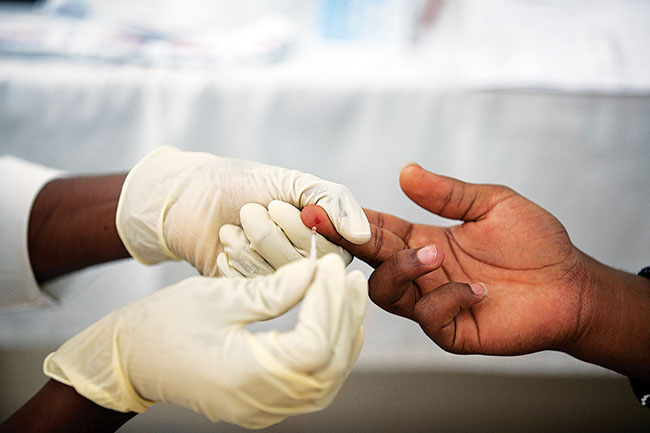CEO of Miss World Julia Morley talks about her COVID-19 speculation
4 years ago
_20200311200327_20200312135245.jpg)
4 years ago

4 years ago

4 years ago

Malaria is a parasitical disease transmitted by mosquito bite. The parasite named Plasmodium is the real cause of this disease. The malaria parasite is injected into a human body by the mosquito while sucking blood. Once inside the body, it multiplies in liver before infecting red blood cells.
The incubation period of malaria may vary from one week to three weeks depending on the species. “Around six species of malaria-causing Plasmodium are recorded in humans but Plasmodium Vivex is common in Nepal. More than 82 percent of malaria cases in Nepal are caused by Plasmodium Vivex,” said Dr Anup Bastola, tropical medicine physician at Sukraraj Tropical and Infectious Disease Hospital, Teku.
 To mark the efforts made to eliminate malaria from the world, April 25 is celebrated as world malaria day across the globe every year.
To mark the efforts made to eliminate malaria from the world, April 25 is celebrated as world malaria day across the globe every year.
Foothills and river belts, forest fringe areas, forests of Tarai area, inner valleys and some Tarai districts are considered to be highly risky for malaria transmission in Nepal. To study about malaria (especially in the Tarai region), a malaria control project was launched in 1954 with support from United States Agency for International Development (USAID). Later in 1958, national malaria eradication program was launched, which was later renamed as malaria control program.
“Recently we are working on National Malaria Elimination Program which aims to eliminate malaria from Nepal within 2025,” said Dr Bibek Kumar Lal, senior health administrator at Epidemiology and Disease Control Division.
According to a micro-stratification study performed by National Malaria Elimination Program in 2016, as many as 169,747 persons are at high risk of malaria. Similarly, around 1,357,723 are living at a moderate risk of malaria in Nepal. To control malaria in areas where malaria is common or where malaria can be seen, government sprays insecticides twice a year. Likewise, the government also distributes one mosquito net for every two persons who live in areas with moderate or high risks of malaria. According to the micro-stratification study, 12 districts of Nepal are considered to be at high risk of malaria and 15 districts at moderate risk.

“Though we are making lots of effort to eliminate malaria from the country, lack of proper reporting of indigenous and imported malaria is creating difficulties for us,” said Bastola. “In recent years, we have noticed higher rate of imported malaria than indigenous malaria.”
If a person gets infected within Nepal, then that malaria is called indigenous malaria whereas if a person gets infected abroad but symptoms are seen only after returning to Nepal, then it is called imported malaria. According to Bastola, “To prevent imported malaria, people can take anti-malarial medicines like Doxycycline, Chloroquine and Mefloquine before visiting malaria-prone countries.”
According to the data of Epidemiology and Disease Control Division, 1128 malaria cases was recorded in Nepal, and 636 of them were imported.
Malaria is transmitted from one person to another person through the bite of female anopheles mosquito. So this disease can be controlled by controlling mosquitos. “Those who are involved in outdoor activates are prone to malaria,” said Bastola.
Mosquitos are controlled through different measures like putting kerosene in open water sources and keeping small water sources covered. This will destroy the eggs and larva of mosquito. Similarly, we can prevent mosquitos from entering our rooms by covering windows and doors with net.
“We recommend people to use medical mosquito nets because these nets are coated with insecticide that repeals mosquito,” Bastola said. Using mosquito repellent ointments, wearing full-sleeve clothes, spraying insecticides regularly are some of the measures to keep off mosquitoes.
Two types of malaria are common in Nepal: those caused by Plasmodium Falciparum and Plasmodium Vivex. According to Bastola, “Though very few number P. Falciparum malaria is recorded in Nepal, it might get fatal if not treated on time.” According to the data of Epidemiology and Disease Control Division, only 148 cases of P. Falciparum malaria were recorded in last fiscal year.
 Malaria may be either complicated or uncomplicated. Symptoms of uncomplicated malaria include flu-like symptoms, headache, arthralgia, myalgia, malaise and so on. Whereas complicated malaria may results in hypoglycemia, hemorrhage, and even damage to central nervous system which may result to coma. Similarly, complicated malaria can damage liver and kidney as well, so it is important to consult a doctor if any malarial symptoms are seen. Complicated malaria are caused by P. Falciparum.
Malaria may be either complicated or uncomplicated. Symptoms of uncomplicated malaria include flu-like symptoms, headache, arthralgia, myalgia, malaise and so on. Whereas complicated malaria may results in hypoglycemia, hemorrhage, and even damage to central nervous system which may result to coma. Similarly, complicated malaria can damage liver and kidney as well, so it is important to consult a doctor if any malarial symptoms are seen. Complicated malaria are caused by P. Falciparum.
Leave A Comment